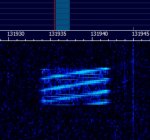chgomonitor
Silent Key
Requesting help identifying these HF data squitters I've been catching all up and down the bands. Attaching a somewhat poor quality .wav file I captured tonight.
Did an informal freq survey for these things across the 5 MHz band tonight and came up with;
5260
5290
5320
5350
5370
5380
5405
5430
5435
5750
These things seem to come and go at random between at least 5 and 10 Megs. Very distinct and rather wide squiggly RF waveform with lots of little audio peaks inside each squitter. Looks like some type of MFSK data burst. Looks like some variations in signal strength between the signals from here in the Midwest. They seem to come and go in some odd series, but almost random. Never very active on any single given freq. Might catch 2 or 3 in 4 or 5 minutes, then silent for 10 or 20 minutes. But as a network it seems to be always on. A couple of times I thought I observed some exchange type patterns, like groups were talking back and forth - but I could be wrong about that.
I'd love to take a crack at actually reading the little things, but for now I'd more than happy to learn what this network is. Anyone? Thanks in advance and...
Happy Scanning! - Ted
Did an informal freq survey for these things across the 5 MHz band tonight and came up with;
5260
5290
5320
5350
5370
5380
5405
5430
5435
5750
These things seem to come and go at random between at least 5 and 10 Megs. Very distinct and rather wide squiggly RF waveform with lots of little audio peaks inside each squitter. Looks like some type of MFSK data burst. Looks like some variations in signal strength between the signals from here in the Midwest. They seem to come and go in some odd series, but almost random. Never very active on any single given freq. Might catch 2 or 3 in 4 or 5 minutes, then silent for 10 or 20 minutes. But as a network it seems to be always on. A couple of times I thought I observed some exchange type patterns, like groups were talking back and forth - but I could be wrong about that.
I'd love to take a crack at actually reading the little things, but for now I'd more than happy to learn what this network is. Anyone? Thanks in advance and...
Happy Scanning! - Ted


